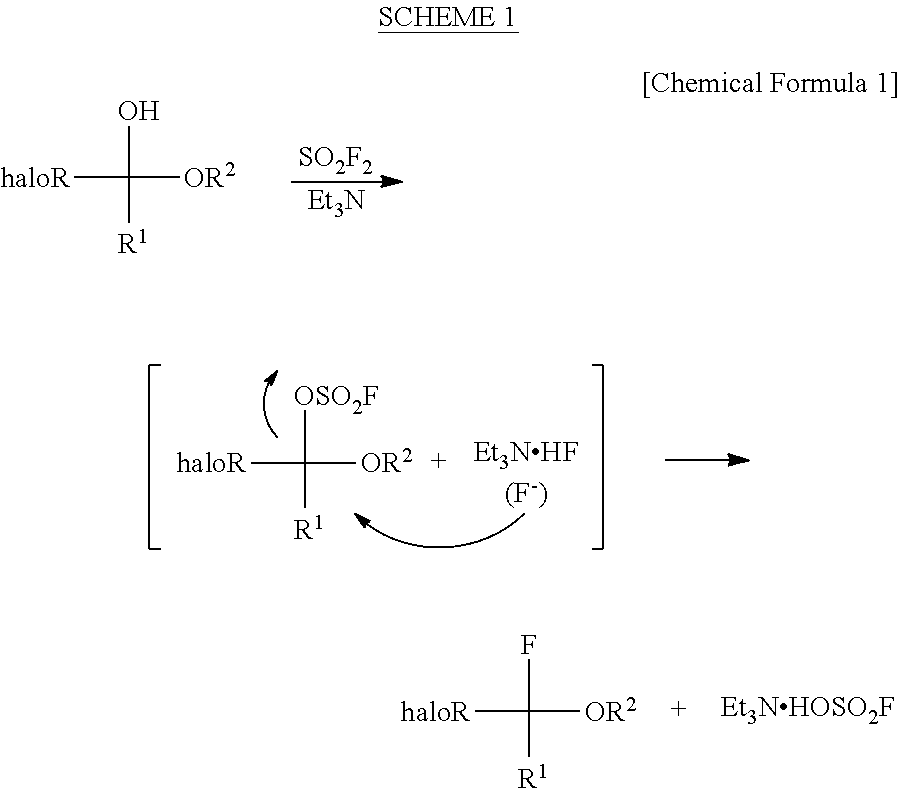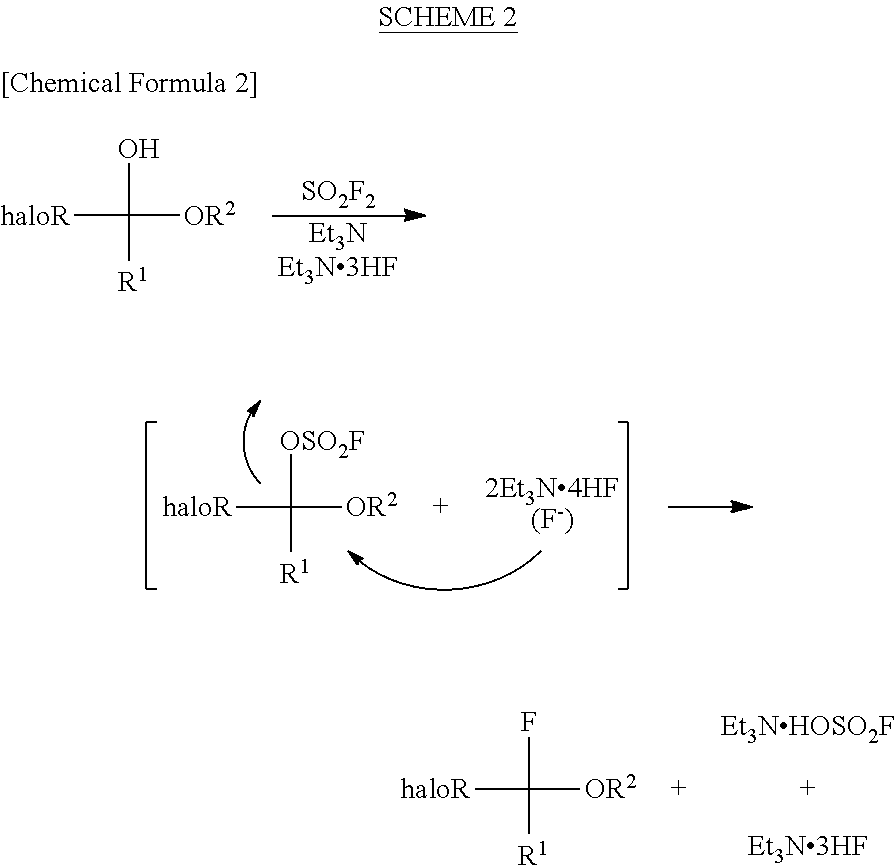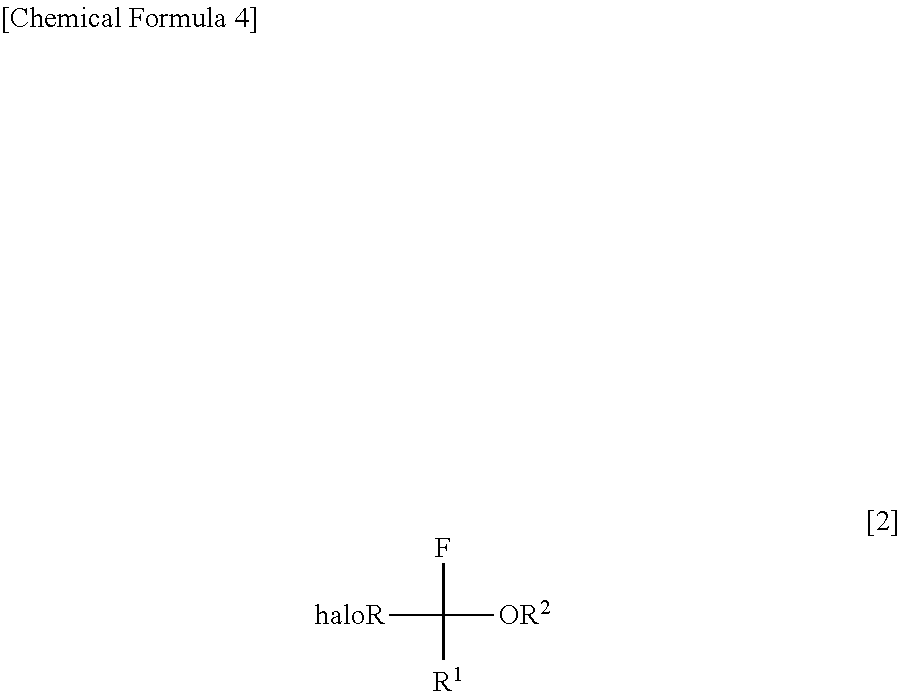Process for Production of Halogenated alpha-Fluoroethers
a technology of alpha-fluoroether and process, which is applied in the preparation of carboxylic acid esters, chemistry apparatus and processes, and organic chemistry, etc., can solve the problems of inability to expect high productivity, complicated operations including post-treatment, and difficult industrial execution of such operations, and achieve high selectivity and yield
- Summary
- Abstract
- Description
- Claims
- Application Information
AI Technical Summary
Benefits of technology
Problems solved by technology
Method used
Image
Examples
example 1
[0068]A pressure-proof reaction vessel made of stainless steel (SUS) was charged with 500 mg (3.47 mmol, 1.00 eq) of halogenated hemiacetals represented by the following formula
, 3.5 mL of acetonitrile, 1.756 mg (17.35 mmol, 5.00 eq) of triethylamine and 839 mg (5.20 mmol, 1.50 eq) of triethylamine tris(hydrogen fluoride) complex, followed by immersing it in a coolant bath of −78° C. Then, 708 mg (6.94 mmol, 2.00 eq) of sulfuryl fluoride (SO2F2) was blown thereinto by using a bomb, followed by stirring at room temperature throughout the night. The reaction-terminated liquid was confirmed by 1H-NMR and 19F-NMR to have a conversion rate and a selectivity of 100% and not less than 70%, respectively. By directly distilling the reaction-terminated liquid (at normal pressure), halogenated α-fluoroethers represented by the following formula
can be obtained as a mixture of triethylamine and acetonitrile. The yield was confirmed by the conversion rate and the selectivity of the reaction-termi...
example 2
[0071]In conformity with YUKIGOSEIKYOKAISHI (Japan), 1999, Vol. 57, No. 10, p. 102-103, fluoral (gas) was generated from an excessive amount of fluoral monohydrate, followed by blowing it into allyl alcohol. Stirring was conducted for 2 hours at room temperature, thereby obtaining halogenated hemiacetals represented by the following formula
at a quantitative yield.
[0072]A pressure-proof reaction vessel made of stainless steel (SUS) was charged with 1.56 g (9.99 mmol, 1.00 eq) of halogenated hemiacetals represented by the above formula, 10 mL of acetonitrile, 4.05 g (40.02 mmol, 4.01 eq) of triethylamine and 1.61 g (9.99 mmol, 1.00 eq) of triethylamine tris(hydrogen fluoride) complex, followed by immersing it in a coolant bath of −78° C. Then, 2.04 g (19.99 mmol, 2.00 eq) of sulfuryl fluoride (SO2F2) was blown thereinto by using a bomb, followed by stirring at room temperature throughout the night. The reaction-terminated liquid was confirmed by 1H-NMR and 19F-NMR to have a conversion...
example 3
[0075]An excessively small amount of methanol was added to ethyl 3,3,3-trifluoropyruvate and then stirred at room temperature throughout the night, thereby obtaining halogenated hemiacetals represented by the following formula
at a quantitative yield.
[0076]A pressure-proof reaction vessel made of stainless steel (SUS) was charged with 500 mg (2.47 mmol, 1.00 eq) of halogenated hemiacetals represented by the above formula, 2.5 mL of acetonitrile, 1.000 mg (9.88 mmol, 4.00 eq) of triethylamine and 399 mg (2.47 mmol, 1.00 eq) of triethylamine tris(hydrogen fluoride) complex, followed by immersing it in a coolant bath of −78 ° C. Then, 505 mg (4.95 mmol, 2.00 eq) of sulfuryl fluoride (SO2F2) was blown thereinto by using a bomb, followed by stirring at room temperature throughout the night. The reaction-terminated liquid was confirmed by 1H -NMR and 19F-NMR to have a conversion rate and a selectivity of 100% and not less than 70%, respectively. The reaction-terminated liquid was directly ...
PUM
| Property | Measurement | Unit |
|---|---|---|
| Selectivity | aaaaa | aaaaa |
Abstract
Description
Claims
Application Information
 Login to View More
Login to View More - R&D
- Intellectual Property
- Life Sciences
- Materials
- Tech Scout
- Unparalleled Data Quality
- Higher Quality Content
- 60% Fewer Hallucinations
Browse by: Latest US Patents, China's latest patents, Technical Efficacy Thesaurus, Application Domain, Technology Topic, Popular Technical Reports.
© 2025 PatSnap. All rights reserved.Legal|Privacy policy|Modern Slavery Act Transparency Statement|Sitemap|About US| Contact US: help@patsnap.com



